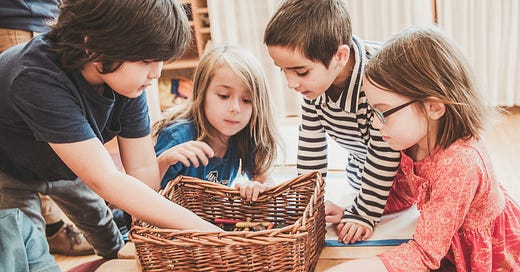✅ Habits to Start Strong in First Grade
Because Six- and Seven-Year-Olds Are Looking for Leadership—Not Chaos
Scroll to the bottom to listen to the recording that goes with this post (paid subscribers).
First grade is such a beautiful but important moment. The children are stepping out of the dreamy world of early childhood and into something more structured, more purposeful—but they’re still very much young children. The big shift isn’t just in the curriculum—it’s in the feeling of the day, the way the class starts to move as one.
This is when we really begin forming the class. And it’s kind of a make-or-break moment for teachers. You really have the potential to make the next few years smooth sailing, so it’s good to take the time to form the class right.
Here are a few grounded habits that can make a big difference in those first weeks (and months!) of first grade.
1. Lean on Rhythm—and Keep It Simple
Children this age are looking for something steady. A predictable rhythm—daily and weekly—helps them feel safe. It lets their nervous systems relax so they can actually learn.
So, yes: begin the day the same way. Use the same song to tidy up. End with a closing verse or quiet story. These aren’t just sweet rituals—they're tools for building a classroom that runs on trust and ease. You’ll honestly be surprised how many times you can repeat things with first graders.
2. Start with Movement, Not Sitting
Six- and seven-year-olds are not built to sit still and take in verbal instructions right away. Start the morning with movement—walking, skipping, clapping patterns, beanbag games. Not just to burn off energy, but to build coordination, spatial awareness, and attention.
This is brain-building stuff, and it helps settle the group before moving into more focused work.
3. Model Everything. Then Model It Again.
Don’t assume they know how to line up, sharpen a pencil, or walk through a doorway without knocking into someone. Teach it. Show them how to do it well, and do it slowly. Then do it again tomorrow.
It can feel repetitive at first, but children this age are actively seeking direction. They want to know how things work, what’s expected, how to belong. So don’t be afraid to lead. You’re not being strict—you’re offering structure they can relax into.
4. Practice Listening in Little Doses
Listening is a muscle. Start small. Echo songs, call-and-response verses, quick games where they have to remember a word or two and pass it along.
And until they’re better at really listening for longer periods of time, make use of those tricks we Waldorf teachers use to keep their attention—imagination. Those first graders can sit still and be attentive for a long time when they’re listening to a good story!
5. Give Them Jobs—and Teach Them Well
Children want to help. They want to be needed. Little classroom jobs—watering the plants, passing out crayons, sweeping the floor—give them a sense of purpose and belonging. And they love it when you trust them with real responsibility.
But just like everything else, you have to model it well. Teach each task slowly and clearly. Then let them take it on.
The beginning of first grade is not about doing it all. It’s about doing a few things really well, over and over, until they become the heartbeat of your classroom. The truth is, children this age are wide open—they’re looking to us for rhythm, for example, for how to be together.
So don’t be afraid to lead. Set the tone. Show them what’s possible.
And then—watch them rise to meet it.
Keep reading with a 7-day free trial
Subscribe to Waldorf at Work to keep reading this post and get 7 days of free access to the full post archives.





